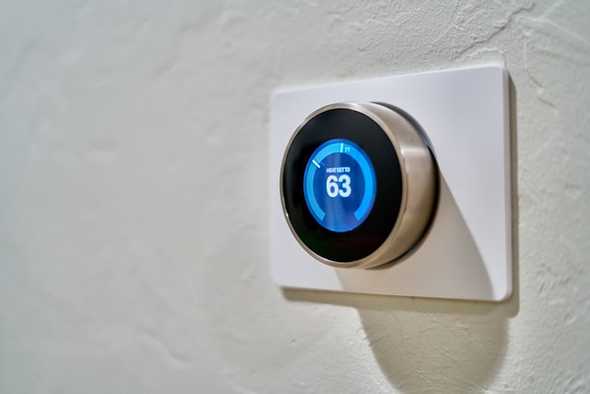Accessing Nest Thermostat with Go
November 17, 2020
 Photo by Dan LeFebvre on Unsplash
Photo by Dan LeFebvre on Unsplash
I found accessing the data from my Nest Thermostat a little over-complicated. There were many pages of documentation required to get things going. Also the examples provided on the official SDK does a lot to obfuscate the important points.
Here you will see the minimal set up to get humidity from your thermostat. Once you have that, making assumptions about the SDK and navigating the documentation will hopefully be a little easier!
Prerequisites
- A Google account
- Access to the developer console
- Golang installed
Here Goes
Create Google Developer Project
Go to the Google developer console and create a new project.
Enable Smart Device Management here (I cannot figure out how to get there with buttons right now)
Once complete click on OAuth consent screen in the left-hand navigation and then EDIT APP.
- Page 1: Fill out the required fields
- Page 2: Click ADD OR REMOVE SCOPES and select all of the Smart Device Management API scopes.
- Page 3 & 4: Continue until complete
After finishing the form, click on the new client to edit it again. This time
there is a page with the client ID and client secret. At this point you should
also add localhost:8080 to the Authorised Redirect URLs.
Create Nest Project
First of all you need to go to the device access page and pay your $5 one-time access fee.
Once that is processed head to the device access project page and click Create project. At the time of writing there is a short series of pages, fill them out like so:
- Name - give your project a name (it can be renamed)
- OAuth client ID - enter the OAuth client ID from your Google project
- Events - disable (beyond scope of this piece)
Time to Code
OAuth 2 Flow
First of all set up the OAuth config.
conf := &oauth2.Config{
ClientID: clientId,
ClientSecret: clientSecret,
RedirectURL: "http://localhost:8080",
Scopes: []string{
smartdevicemanagement.SdmServiceScope,
},
Endpoint: oauth2.Endpoint{
AuthURL: fmt.Sprintf("https://nestservices.google.com/partnerconnections/%s/auth", projectID),
TokenURL: google.Endpoint.TokenURL,
},
}
- Client ID and Secret are from the Google Developer Project
- Project ID is the Nest project, not the Google project
- localhost:8080 is acceptable, this will need setting in the OAuth client config page you created earlier
Next you need a token.
This code will get you a token to use in the HTTP client that will be passed into the Smart Device Management service constructor.
func authenticate(ctx context.Context, config *oauth2.Config) *oauth2.Token {
log.Print("Your browser will be opened to authenticate with Google")
log.Print("Hit enter to confirm and continue")
url := config.AuthCodeURL("state", oauth2.AccessTypeOffline)
codeChannel := make(chan string)
mux := http.NewServeMux()
server := http.Server{Addr: ":8080", Handler: mux}
mux.HandleFunc("/", func(w http.ResponseWriter, r *http.Request) {
w.Write([]byte("<p style=font-size:xx-large;text-align:center>return to your terminal</p>"))
codeChannel <- r.URL.Query().Get("code")
})
openBrowser(url)
go func() {
if err := server.ListenAndServe(); err != nil && err != http.ErrServerClosed {
log.Fatal(err)
}
}()
code := <-codeChannel
log.Print("Shutting down server")
server.Shutdown(context.Background())
log.Print("Exchanging token")
token, err := config.Exchange(ctx, code)
if err != nil {
log.Fatal(err)
}
return token
}
- I used this
openbrowser()function. Does the job. - A web server is set up to handle the redirect. Once it’s job is done, the server is shut down.
- After
config.Exchange(ctx, code)you should cache this and use it in future instead of using the web flow every time. - Later on you will do a much, much better job of this function.
Creating the SDM Service
The service will be used to retrieve data from Google’s Nest APIs. Here the code snippets above will be put together into something that should work…
ctx := context.Background()
token := authenticate(ctx, conf)
httpClient := config.Client(ctx, token)
sdmService, err := smartdevicemanagement.NewService(ctx, option.WithHTTPClient(httpClient))
Time to GET Data
devicesListResponse, err := sdmService.Enterprises.Devices.List(fmt.Sprintf("enterprises/%s", projectID)).Do()
if err != nil {
log.Fatal(err)
}
for _, device := range devicesListResponse.Devices {
m := make(map[string]interface{})
err := json.Unmarshal(device.Traits, &m)
if err != nil {
log.Fatal(err)
}
var nestTraits Traits
err = json.Unmarshal(device.Traits, &nestTraits)
if err != nil {
log.Fatal(err)
}
log.Printf("Temperature: %v", nestTraits.Temperature.Celcius)
log.Printf("Humidity: %v%%", nestTraits.Humidity.Percent)
}
Done
Good luck. As always, contact me via email or drop a PR on GitHub with any suggestions or corrections. Happy to receive.
My application still has a bit of work to do. I am looking forward to keeping a personal copy of all my thermostat data.
I found the following pages useful in this endeavour, you may as well:
- My StackOverflow question where I figure out my auth URL is wrong
- The Smart Device Management dashboard
- Golang OAuth2 documentation
- OAuth 2 sample code
- “Getting Started” guide to Google API Go Client
- Google OAuth 2.0 access documentation
- Google OAuth 2.0 client examples
- Creating a web server with Golang
- Smart Device Management docs
- Partner Connections Manager
- Guide on Reddit to on Nest Hello Doorbell integration
Cheers BYYYYYEEEEEEE